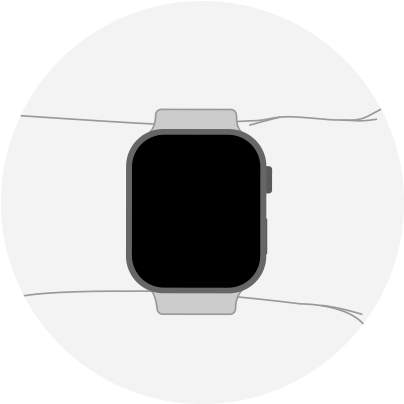
Wearing Your Apple Watch
Learn how to wear your Apple Watch for the best fit and understand potential skin sensitivities.
A Better Fit for More Accurate Measurements
To ensure both comfort and proper sensor function, wear your Apple Watch neither too tight nor too loose, leaving some room for your skin to breathe. You can tighten the strap during workouts and loosen it slightly afterward.
Learn more about achieving optimal results when using the Blood Oxygen app.
Recommended Fit
Illustration of Correct Fit
Your Apple Watch should fit comfortably against your wrist. For features like Wrist Detection, the Taptic Engine, and the electrical and optical heart rate sensors to work effectively, the back of the Apple Watch must be in contact with your skin. To ensure this, wear your Apple Watch above the wrist bone (closer to your elbow, not your hand).
Improper Fit
Illustration of Incorrect Fit
If your Apple Watch shifts out of place or its sensors can’t detect your heart rate, check the positioning and tighten the band. If the watch sits on the wrist bone, move it above the bone. To test if it’s too loose, shake your wrist with your palm facing up. If the back of the watch doesn’t stay in contact with your skin, tighten the strap.
For Solo Loop or Braided Solo Loop bands, ensure the band fits snugly yet comfortably around your wrist. Simply stretch the band over your wrist for easy wear and removal. Note that Solo Loop bands may slightly stretch over time with prolonged use.
For Those with Sensitivities to Certain Materials
We meticulously select materials for every product we make. In addition to meeting regulatory standards, we set even stricter requirements for Apple Watch materials.* Every material that touches your skin undergoes comprehensive evaluation, including:
- Thousands of material composition tests
- Over a thousand wearable trials
- Thousands of toxicological assessments
- Consultation with board-certified dermatologists
Some people may experience unique reactions to specific materials due to allergies, environmental factors, prolonged exposure to irritants such as soap or sweat, or other factors. If you know you have allergies or sensitivities, note that Apple Watch and some bands contain the following materials:
Nickel: Apple Watch models with stainless steel or aluminum cases, the stainless steel components of the Apple Watch Series 4 and later, Apple Watch SE, stainless steel band release buttons, certain Apple Watch bands, and the metal parts of Hermès bands contain trace amounts of nickel. Magnetic components in the watch and bands also contain nickel. However, the nickel content complies with the strict limits set by European REACH regulations. While contact with nickel is unlikely to cause issues, those sensitive to nickel should remain cautious.
Acrylates: The adhesives in Apple Watch cases, Milanese bands, Modern Buckle bands (leather and woven styles), Leather Loop bands, Ocean bands, Alpine Loop bands, Sport bands, Sport Loop bands, Solo Loop bands, Braided Solo Loop bands, and woven nylon bands contain small amounts of acrylates and methacrylates. These substances are commonly found in consumer products that come into contact with skin, such as adhesive bandages. Some individuals may be allergic to these substances or develop sensitivities after extended use. Apple Watch and its bands are designed to minimize direct skin contact with components containing acrylates and methacrylates.
Other Potential Causes of Skin Discomfort
Skin irritation can also result from wearing your Apple Watch too tightly or too loosely. A strap that’s too tight can cause skin irritation, while a loose strap may cause friction. If you experience redness, swelling, itching, or any other form of irritation, consult a physician before continuing to wear your Apple Watch.







